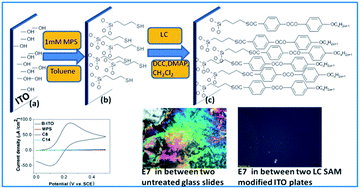Liquid crystal (LC) monolayer on Indium Tin Oxide (ITO): structural and electrochemical characterization†
Abstract
A simple but effective approach to modify transparent Indium Tin Oxide (ITO) substrate with a monolayer of thermotropic liquid crystal (LC) compound containing a terminal carboxylic group and their structural and electrochemical characterization are described. LC compounds employed for monolayer preparation exhibit smectic and nematic phases in bulk. A two-step process was adopted for the immobilization of the LC compound on an ITO electrode which involves the initial formation of a mercaptopropyltrimethoxy silane (MPS) self-assembled monolayer (SAM), followed by the condensation of LC acid onto it through a N,N′-dicyclohexylcarbodiimide (DCC) mediated coupling reaction. Step-wise characterization of the wetting behavior and surface morphology of the SAMs was carried out through contact angle measurements (CA) and atomic force microscopy (AFM) studies, respectively. The quality of the SAM was further assessed by studying the electron transfer process across the modified electrode–electrolyte interface by employing electro-chemical techniques namely cyclic voltammetry (CV) and electrochemical impedance spectroscopy (EIS) using potassium ferro/ferricyanide as a redox probe. As indicated from CV and EIS studies, both MPS modified and LC functionalized ITO substrates exhibit excellent blocking behaviour towards the electron transfer reaction across the electrode–electrolyte interface confirming the presence of dense, well-packed monolayer films. Very high charge transfer resistance (Rct) values and lower rate constant values by up to 4 orders of magnitude compared to bare ITO as determined for both the SAMs from impedance spectroscopy measurements, additionally support the formation of high quality monolayer films. The method described is highly reproducible and the resulting SAMs are stable for several months. Further, versatility of these LC SAM modified ITO electrodes for orientation of the bulk LC sample is also analysed and preliminary results are presented.


 Please wait while we load your content...
Please wait while we load your content...